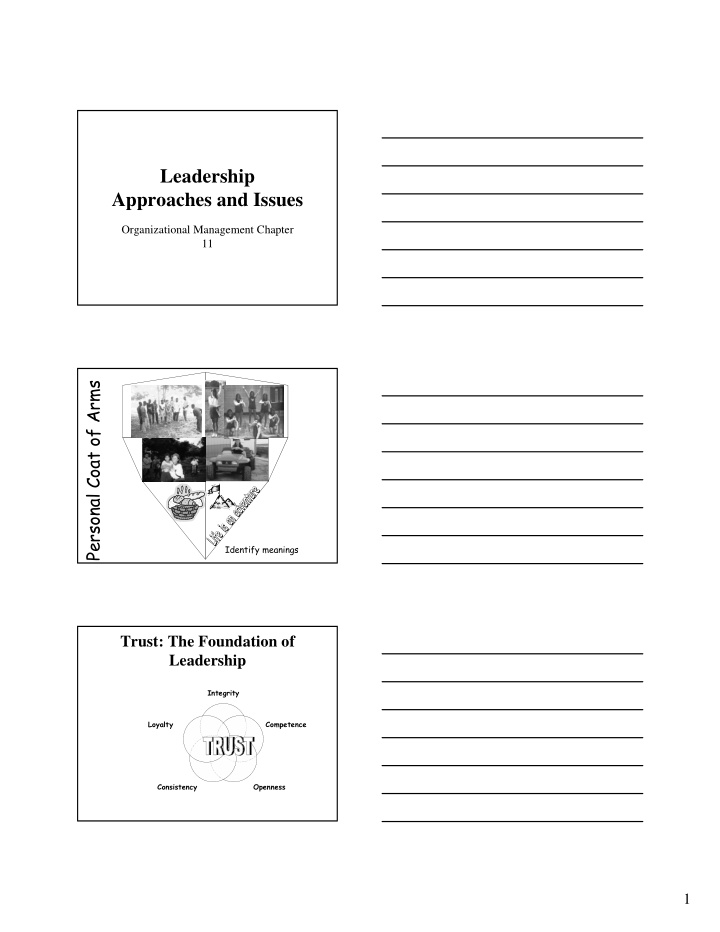



Leadership Approaches and Issues Organizational Management Chapter 11 ��������������������� ����������������� Trust: The Foundation of Leadership ��������� ������� ���������� ����������� �������� 1
�������������������� ���������� ����� ��� ��������� Blake and Mouton’s Leadership Grid High Autocratic Democratic Leader Leader ������������ ��� Laissez-faire Human relations Leader Leader Low Low High ������������������ 2
Fiedler’s contingency model House Path Goal Leadership ��������� ������������� ���������� ����������� �������� Leader Roles in the Path-Goal Model Path Clarification Increase Rewards Leader defines what follower must Leader learns follower’s needs do to attain work outcomes Leader matches follower’s needs to re- Leader clarifies follower’s work role wards if work outcomes are accomplished Follower has increased knowledge & Leader increases value of work confidence to accomplish outcomes outcomes for follower Follower displays increased effort & motivation Organizational work outcomes are accomplished Bass, Leadership: Good, Better, Best 1985 3
Vroom-Jago Leader- participation theory authority consultative group �������������������������������������������������������� � Lack sufficient info � Have all expertise � Problem unclear � Confident/capable of acting alone � Acceptance by others to implement � Others will accept decision � Adequate time � Little or no time Substitutes and Neutralizers for Leadership Issues in Leadership Development � Transactional � Charismatic � Transformational 4
Charismatic Leadership Vision Unconven- Personal tional risk behavior ��!"�� Environ- Sensitive mental of follower sensitivity needs Charismatic Leadership: the downside Charles Milles Manson (born 1934-NOV-11) is a person with an unusual ability to dominate others. He assembled a destructive cult around himself, which the media later called The Family . At one time, it numbered in excess of 100 individuals at the Spahn Ranch some 30 miles northwest of Los Angeles CA. Manson was referred to both as "God" and "Satan" by his followers. As the family's guru, he claimed to be a reincarnation of Jesus Christ. On November 18, 1978, over 900 members of a religious group led by the Reverend Jim Jones were killed in an apparent mass suicide. The megalomaniac Jones convinced most of his followers to drink a cyanide mixture. Some, including Jones, were shot, either in suicide or murder. Transformational � Vision � Charisma � Symbolism � Empowerment � Intellectual stimulation � Integrity � Emotional intelligence 5
Visionary Leadership The ability to create and articulate a realistic, credible, attractive vision of the future for an organization or organizational unit that grows out of and improves upon the present. Qualities of a vision: Evokes superior imagery Inspiration is Well-articulated value-centered Realizable Visionary Leadership � Challenge the process � Be enthusiastic � Help other to act � Set the example � Celebrate achievements 6
Visionary Leaders Extend the Have the vision to ability to different explain vision leadership to others contexts Use own behavior to express vision Transactional � Directs actions of others � Tasks � Rewards � Structures Transactional & Transformational Leadership ������������� ���������������� ������������������� ���������������������� ������������������� ���������������� ����������������� ������������������������ • Contingent Reward • Charisma • Management by • Inspiration Exception (active) • Intellectual Stimulation • Management by • Individual Exception (passive) Consideration • Laissez-Faire 7
Two fundamental differences �������������������������� ���������������������� ���������������!������!�� �� ��������������������� "���������������������� ������������������������ ����������������������� ���������� E-age Leadership � Reliance on Technology transcends the need for strong leadership skills Leadership in Different Cultures � Headship � Paternalism � Director 8
International Contingency Model : Appropriate Path-Goal Leadership Styles Directive Supportive Participative Achievement- Country Oriented Australia Brazil Canada France Germany Great Britain Hong Kong India Italy Philippines Sweden Taiwan United States Finding and Creating Effective Leaders � Selection � Review specific requirements for the job. � Use tests that identify personal traits associated with leadership, measure self-monitoring, and assess emotional intelligence. � Conduct personal interviews to determine candidate’s fit with the job. � Training � Recognize the all people are not equally trainable. � Teach skills that are necessary for employees to become effective leaders. � Provide behavioral training to increase the development potential of nascent charismatic employees. Improving your leadership capabilities � Assessment � Your own capabilities � Follower’s capabilities � Situational constraints 9
Benjamin Franklin � Justice � Temperance � Moderation � Silence � Cleanliness � Order � Tranquility � Resolution � Chastity � Frugality � Humility � Industry � Sincerity The Five Temptations of a CEO � CEO more interested in protecting career status than in making sure the company achieves results. � CEO wants to be popular with direct reports instead of holding them accountable. � CEO wants to ensure decisions are correct. � CEO desires harmony. � CEO fears being vulnerable. Lencioni, Patrick, “The Five Temptations of a CEO”, 1998 Overcoming the Five Temptations Choose trust over invulnerability Choose conflict over harmony Choose clarity over certainty Choose accountability over popularity Choose results over status Lencioni, Patrick, “The Five Temptations of a CEO”, 1998 10
Recommend
More recommend